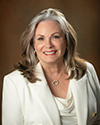Interviews by Jessica Johnson and Abby Lestin
Big deal, little deal or no deal?
In a hypothetical survey among several dozen women who work in commercial real estate that examines the significance of their growing segment of industry leadership, answers would likely run the gamut of those three options.
The answer is subjective, of course. But regardless of individual sentiments, there can be no denying that commercial real estate does currently have a strong cast of experienced, capable women in leadership positions, and there is little reason to think that trend will slow or backtrack in the future.
At France Media, the Atlanta-based parent company of Texas Real Estate Business, we see this pattern manifest in multiple forms. Our conference division, InterFace Conference Group, hosts dozens of industry events every year with panel discussions that routinely feature women in prominent speaking roles. We see more announcements about advocacy groups within the industry that are largely devoted to women and their occupational advancement and achievements, as well as launches of companies owned and led by women. And we count a growing contingent of women among our regular editorial sources and contributors.
This isn’t just some initiative driven by diversity, equity and inclusion (DEI). It’s a natural evolution of the workplace, which doesn’t always unfold at the same pace in every industry. And sociologically, real estate is pretty deeply entrenched in masculinity: real estate is buildings, and men are traditionally builders.
But without going too deep down the gender-normative rabbit hole, while it’s fair to say that while this basic premise of how real estate is conceived is rooted in thousands of years of history, in the 21st century, the actual practices of real estate are incredibly varied. For this reason, it only follows that the industry would naturally embrace more diverse slates of practitioners.
In an effort to learn more the evolution of female leadership in the industry and to talk about something other than interest rates, Texas Real Estate Business queried six women in executive positions in different fields and areas of expertise across the state. Their perspectives on the subject of female leadership in the business that is commercial real estate, as well as their thoughts on more pressing issues (okay, so there is a little bit of interest rate talk) are outlined in the following Q&A. The list of participants consisted of:
• Edna Meyer-Nelson, founder, president and CEO of The Richland Cos.
• Sonya Bly, CEO of Anchor Construction
• Elaine Howard, senior counsel and shareholder at Andrews Myers PC
• DeLea Becker, founder of Beck-Reit Commercial Real Estate
• Nathaliah Naipaul, CEO and partner at XAG Group
• Linda McMahon, CEO of Dallas Economic Development Corp.
Their slightly edited responses are as follows:
Texas Real Estate Business: To what extent has the subject of women in commercial real estate become more or less of a storyline as more women have actually entered the industry and ascended within its ranks?
Edna Meyer-Nelson: Women have slowly taken their position in the real estate industry with vim, vigor and knowledge of how to grow and make their presences known. They are knowledgeable and eager to help other women.

Sonya Bly: The narrative surrounding women in commercial real estate has significantly transformed. With more women entering and taking on leadership roles, we’ve shifted from merely discussing underrepresentation to celebrating achievements and advocating for greater inclusion. It’s empowering to witness the growing visibility of women making substantial contributions in this field.
Elaine Howard: In my 30-year career, I’ve seen a substantial influx of women into the areas of law and real estate. The current, important storyline is retention. There are so many pressures on women that it is still difficult to keep women on the path to obtain full-time leadership positions; these pressures also negatively impact their prospects for promotion.
DeLea Becker: The conversation about women in commercial real estate has intensified since COVID, especially as reports in 2020-2021 highlighted how much domestic work fell on working women. According to Commercial Real Estate Women Network (CREW), women held about 9 percent of executive roles in 2023, up from 8.4 percent in 2019 — a modest increase. The real shift has been in how women are using social media, podcasts and other platforms to become more vocal, especially in higher ranks, amplifying their presence and reshaping industry conversations.

Nathaliah Naipaul: The story of women in commercial real estate has definitely evolved. At one time, it was all about celebrating the “firsts” but now, as more women have entered the industry and ascended to leadership roles, it’s become more about the impact they’re having, not just their presence. At XAG Group, it’s not just about being a woman in real estate — it’s about being a leader and a mentor. However, we still recognize that the story isn’t over. Women continue to face unique challenges, and there’s always more to be done to level the playing field.
Linda McMahon: Women are now leading significant commercial real estate companies: Sue Ansel is head of Gables Residential; Michele Wheeler is president of Jackson Shaw. More and more women are in leadership roles, not only at the top but in other levels of the largest commercial real estate companies.
TREB: What are some aspects of working in this industry that really lend themselves to the female disposition, i.e. — people skills, empathy, multi-tasking/ attention to detail?

Meyer-Nelson: Women have always given more attention to detail. But in real estate, they not only bring dynamic people skills and empathy but also the financial knowledge that it takes to achieve success.
Bly: Several aspects of this industry align well with skills often associated with women. Strong people skills and empathy are essential for relationship-building, negotiation and client relations. I’ve seen firsthand how women excel in these areas, fostering collaborative environments that drive success. Additionally, the ability to multitask and maintain attention to detail is crucial in managing complex projects and enhancing operational efficiency.
Howard: I don’t know if it is nature or nurture, but women are less focused on coming out the winner and more focused on getting the deal done. Some clients still want a “bulldog,” which is often code for “male,” but most are happier with a focus on solutions and reasonable, efficient pathways to get to those solutions.

Becker: Women in commercial real estate excel through strategic focus, methodical planning and holding high standards that leave no room for error. It is the nature of competing in a male-dominated industry; we must be tenacious and always two steps ahead. We play every scenario — hope for the best and plan for the worst. We don’t just multitask; we orchestrate deals with precision, and that’s exactly why women thrive in this business.
Naipaul: In our company, we see it in action every day. Women, including many of our team members, are often juggling multiple roles both in and out of the office. That attention to detail and ability to multi-task is invaluable when you’re managing long-term development projects that require navigating relationships, timelines, and budgets all at once. It’s about being able to see the bigger picture while staying connected to the fine details that make a project successful.

McMahon: All of the above. Women are also great listeners and can translate what their clients want into providing the best real estate specific for that client, in addition to their ability to execute.
TREB: Are you aware of or involved with any initiatives to actively promote the growth of women in commercial real estate, and if so, can you share some details of that program(s)?
Meyer-Nelson: I am chairwoman of a national bank in which 71 percent of our shareholders are women. We are striving to be a bank that is ready and willing to assist women with loans and opportunities.
Bly: I’m currently involved in initiatives aimed at promoting the growth of women in commercial real estate. While I’m contributing where I can, I’m eager to continue striving for greater involvement and to help foster a supportive community where women can thrive in this industry. It’s vital to create a supportive community that empowers women.

Howard: I am the president of the Houston chapter of CREW. Our mission is to advance the careers of all women in commercial real estate through business networking, leadership development, career outreach and industry outreach. We are part of CREW Network, an international organization with over 14,000 members in 80 chapters in five countries. In Houston, we have regular programs to update our audience on key real estate trends, such as developments in different regions of Houston. We also have members-only events with an emphasis on leadership development, soft skills and networking.
Becker: As a long-time member of CREW Austin, the biggest advantage I’ve gained is speed-to-trust when connecting with other women in the industry that are fellow CREW members. Programs like UCREW, where university women compete in case studies for scholarships, help foster real-world experience and build solid networks. Thanks to my decade of involvement with CREW, I now have two CREW women as partners in an office development, WORKBENCH, in East Austin. Three of the six equity partners are women and founders of their companies whom I initially met at CREW Austin.
Naipaul: One of the organizations I am actively involved with is MOXIE, an organization built by women for women that focuses on empowering women in the workplace and guidance throughout life. I am also very passionate about personally mentoring young women who are just getting started in their careers, sharing insights and advice from my own journey. As a company, we believe in creating opportunities at every level, from offering internships to partnering with local schools to helping young women see real estate as a viable and exciting career path. It’s about creating an environment where women feel empowered to not just participate but also to lead.
TREB: What do you see as the most pressing issue(s) facing commercial real estate in Texas as we approach the new year?
Meyer-Nelson: Office buildings will continue to lag in the industry. Retail strip centers in growth areas will continue to maintain while industrial business parks will excel.
Bly: As we approach the new year, I see several pressing issues facing commercial real estate in Texas. Economic volatility poses challenges that could affect investment confidence. We’re also navigating increasing regulations around sustainability, which will require us to adapt our strategies. Additionally, specific asset classes, like office and retail, continue to feel the impact of remote work and e-commerce trends.
Howard: The office sector is worrisome. The majority of workers in professional fields still work at least part of the time from home, leaving many employers with ongoing pressures to downsize office space. It may not be as tempting to other businesses to require full-time in-office work after the serious backlash against companies like Amazon. Also, many companies no longer have the office space to require full-time, in-office work. Some Houston business centers, such as Greenway, face hard decisions about their future.
Becker: Texas’ explosive growth is a double-edged sword, creating opportunities but also putting immense pressure on our resources and infrastructure, especially outside major metros. Water utility providers are having to prioritize major capital projects, such as new lines and wells, which slows down developments and significantly inflates costs. In my Plan B RV project, for example, we’re paying over 10 times the typical cost to simply “upgrade the water meter” — after being in the queue for 640 days. Water providers are being forced to overhaul systems, and in some areas, this process is slow, leaving development nearly at a standstill.
Naipaul: We want all of our tenants to feel like they are part of a community. In retail, we feel creating a partnership with the tenants gives us the opportunity to understand their business models so we can create a building meeting all of their needs, ensuring success for everyone. In multifamily, we pride ourselves on creating an environment where a tenant will not want to leave.
McMahon: The changing financial markets continue to be an issue with financing projects, even though there is sufficient capital in the market. The constantly changing needs of companies relative to office space — not only how much space they need but also what amenities are needed to attract occupiers ‚ is another issue. Construction costs, land costs and operating costs also continue to rise and impact what can be built. Technological advances and digital disruption are also significant challenges in commercial real estate.
TREB: Within the markets/ sectors in which you specialize, how would you characterize the current supply-demand balance, and what does that mean for development and investment in 2025 and beyond?
Meyer-Nelson: There will still be a demand for industrial and manufacturing real estate to be owned, purchased and sold in the next two to three years.
Bly: In sectors like multifamily and industrial, the supply-demand balance remains tight, driven by population growth and shifting consumer preferences. This suggests robust development opportunities, but we must analyze market dynamics carefully to ensure successful investments in 2025 and beyond.
Becker: The market I specialize in is simple — anything that makes money with a five- to 20-year horizon. In Central Texas, aside from office, other asset classes like warehouses and retail are in high demand. Austin retail is holding at 2 to 3 percent vacancy, and while year-over-year rent growth has slowed, open space is leased quickly, often before hitting the market. If you can handle high construction costs and interest rates — or like many of us, have been sitting on cash and are now deploying it into developments — it’s a great time to build. That’s why I’m currently developing a 24-acre RV park, a 25,000-square-foot office/warehouse project, and a 50,000-square-foot office building. The office building in East Austin is a strategic play — designed to be better, special and different, attracting quality tenants — and we’re already 75 percent preleased by owner-occupants, with 66 percent of the firms being women-led.
Naipaul: In Houston, we’re seeing a lot of demand for multifamily properties, yet supply has halted due to economic conditions. With multifamily demand continuing to be strong given the population growth in Texas, we strongly believe in providing complimentary retail services to the area of development. In 2025 and beyond, we expect to see more innovation and adaptation in this space — creating more flexible, people-centric designs that can evolve with the communities the properties are a part of.
McMahon: Within economic development, we are not engaged directly in the industry, but the access to housing has a critical impact in business expansions and relocations.
TREB: What expectations do you have with regard to capital markets activity in 2025?
Meyer-Nelson: Obviously, if there were interest rate cuts that would help. But debt maturities for the next year will be tough concerning renewals of current debt for borrowers that have been with a lender for a length of time. There should be capital available if you have an opportunity and a purpose for any distressed opportunity that you can purchase if it is for the right price.
Bly: Looking ahead, I anticipate some interesting developments in capital markets activity for 2025. Potential interest rate cuts could stimulate borrowing and investment, while the prospect of acquiring distressed assets may become more appealing as debt maturities approach. While some investors may adopt a cautious stance, there should be significant opportunities for those willing to navigate the complexities of the market. I’m excited about the future of commercial real estate and the role we can play in shaping it, especially as we continue to support and empower women in the industry.
Becker: There’s no shortage of money out there — the real issue is a lack of good deals. In Texas, the smart play is to follow where utilities are expanding, bond elections are passing, Texas Dept. of Transportation dollars are flowing and where economic development sales taxes are funding growth. The best opportunities will be found in areas where public infrastructure and investment are being made, not in waiting for distressed assets that may never come.
Naipaul: We are seeing that capital is still available for the right projects, especially in areas like multifamily where demand remains high. Debt maturities in 2025 could create opportunities for investors to acquire distressed assets, particularly in sectors like office and retail that are still adjusting to post-pandemic realities. However, capital availability is expected to remain strong for well-positioned sectors like multifamily, where demand continues to outpace supply.
McMahon: There appears to be renewed optimism as to what 2025 and beyond will hold. Prospective interest rate cuts and inflation control will provide opportunities for more projects to get underway. Change in tax policy will also impact investment — that will be determined after the election. The top concerns are elevated interest rates, cyber risk, tax policy and cost of capital.
— This Q&A originally appeared in the November 2024 issue of Texas Real Estate Business magazine.


